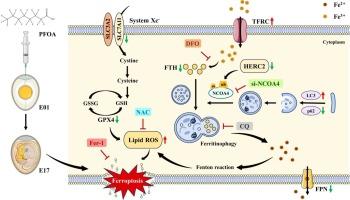ncoa4依赖性铁蛋白自噬驱动全氟辛酸引发的鸡胚胎肾铁凋亡
IF 11.3
1区 环境科学与生态学
Q1 ENGINEERING, ENVIRONMENTAL
引用次数: 0
摘要
全氟辛酸(PFOA)是一种持久性有机污染物,广泛分布于环境中,导致大量生物积累,并引起严重的公共卫生问题。肾脏是PFOA的主要靶器官,但公认的机制尚不清楚。鸡胚作为一种不依赖于母体的毒性模型已被广泛应用于毒性研究。然而,PFOA对鸡胚肾的毒性作用仍然有限。本研究通过空气细胞向鸡胚注射不同浓度的PFOA,建立鸡胚肾(CEK)细胞PFOA暴露体外模型。结果表明,PFOA可促进鸡胚肾的肾毒性,诱导铁下垂。同时,pfoa处理的CEK细胞出现铁下垂,铁下垂抑制剂铁抑素-1 (fer1)、去铁胺(DFO)和自噬抑制剂氯喹(CQ)减轻了铁下垂。进一步的结果表明,PFOA激活了核受体共激活因子4 (NCOA4)介导的鸡胚肾和CEK细胞的铁蛋白吞噬。机制上,PFOA通过降低HECT和含有E3泛素蛋白连接酶2 (HERC2)的RLD结构域的表达,降低NCOA4泛素化,导致NCOA4表达增加,激活铁蛋白自噬。这些结果表明,PFOA通过herc2调控的NCOA4泛素化依赖性降解诱导鸡胚肾铁下垂。本文章由计算机程序翻译,如有差异,请以英文原文为准。

NCOA4-dependent ferritinophagy drives perfluorooctanoic acid-triggered renal ferroptosis in chicken embryos
Perfluorooctanoic acid (PFOA), a persistent organic pollutant, is widely distributed in the environment, leading to substantial bioaccumulation and posing significant public health concerns. The kidney is the primary target organ for PFOA, but a recognized mechanism remains unclear. The chicken embryo has been widely used as a maternal-independent model in toxicity studies. However, the toxic effects of PFOA in chicken embryo kidneys remain limited. In the present study, chicken embryos were injected with PFOA of different concentrations through the air cell to establish an in vivo model, and establish an in vitro model of chicken embryo kidney (CEK) cells for PFOA exposure. The results showed that PFOA promoted nephrotoxicity and induced ferroptosis in chicken embryo kidneys. Meanwhile, ferroptosis occurred in PFOA-treated CEK cells and was alleviated by ferroptosis inhibitor Ferrostatin-1 (Fer-1), Deferoxamine (DFO), and autophagy inhibitor Chloroquine (CQ). Further results suggested that PFOA activated nuclear receptor coactivator 4 (NCOA4)-mediated ferritinophagy in chicken embryo kidneys and CEK cells. Mechanistically, PFOA diminished NCOA4 ubiquitination by reducing the expression of HECT and RLD domain containing E3 ubiquitin protein ligase 2 (HERC2), leading to increased NCOA4 expression and activated ferritinophagy. These findings indicated that PFOA induced ferroptosis via HERC2-regulated NCOA4 ubiquitination-dependent degradation in chicken embryo kidneys.
求助全文
通过发布文献求助,成功后即可免费获取论文全文。
去求助
来源期刊

Journal of Hazardous Materials
工程技术-工程:环境
CiteScore
25.40
自引率
5.90%
发文量
3059
审稿时长
58 days
期刊介绍:
The Journal of Hazardous Materials serves as a global platform for promoting cutting-edge research in the field of Environmental Science and Engineering. Our publication features a wide range of articles, including full-length research papers, review articles, and perspectives, with the aim of enhancing our understanding of the dangers and risks associated with various materials concerning public health and the environment. It is important to note that the term "environmental contaminants" refers specifically to substances that pose hazardous effects through contamination, while excluding those that do not have such impacts on the environment or human health. Moreover, we emphasize the distinction between wastes and hazardous materials in order to provide further clarity on the scope of the journal. We have a keen interest in exploring specific compounds and microbial agents that have adverse effects on the environment.
 求助内容:
求助内容: 应助结果提醒方式:
应助结果提醒方式:


